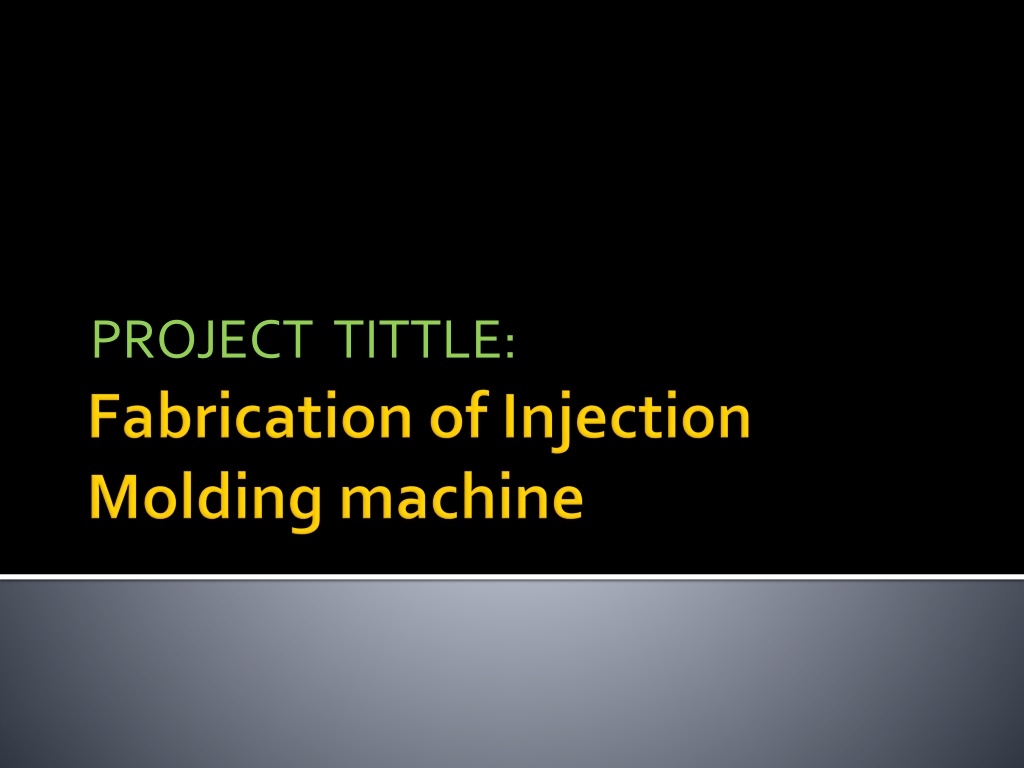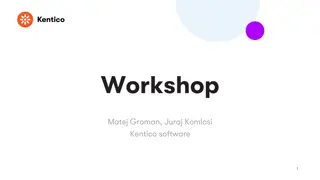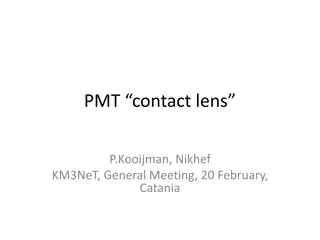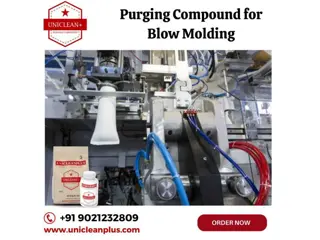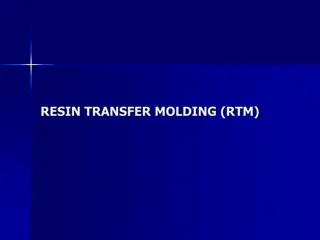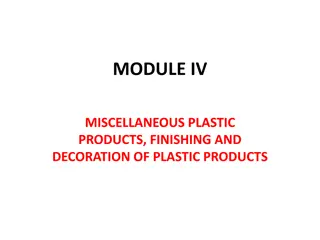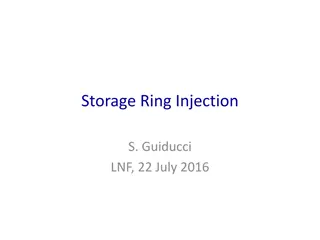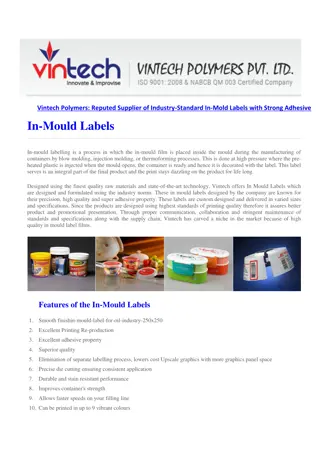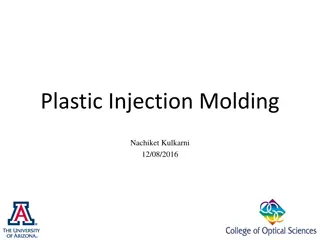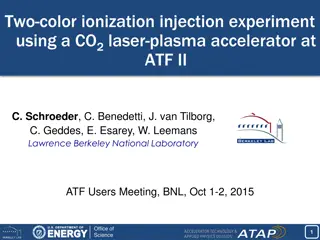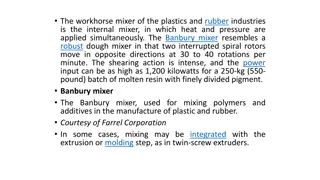Understanding Injection Molding: Techniques and Applications
Injection molding is a versatile manufacturing process that involves injecting material into a mold to produce various parts. This process is crucial in creating products like switches, couplings, and more using different fabrication techniques such as molding and foaming processes. The method is widely used across industries due to its flexibility in working with various materials, including thermoplastics and metals. Learn more about the principles, fabrication techniques, and applications of injection molding in this comprehensive overview.
Download Presentation

Please find below an Image/Link to download the presentation.
The content on the website is provided AS IS for your information and personal use only. It may not be sold, licensed, or shared on other websites without obtaining consent from the author. Download presentation by click this link. If you encounter any issues during the download, it is possible that the publisher has removed the file from their server.
E N D
Presentation Transcript
PROJECT MEMBERS: PROJECT GUIDE:
The project deals about the injection molding machine. The main principle is to compress the plastic material in a barrel and the compressing motion is developed by rotating the rack and pinion arrangement. The plastic material is heated by the heater surrounding the barrel. Then it is converted into molten state. The molten plastic is injected through the nozzle in barrel to the die by the compressing force. After completing this process, we will get the product from the die. Commercial products like bushes, couplings, switches etc., can be produced
FABRICATION TECHNIQUES: The polymer material are converted into plastics and used as tubes, sheets, foams, rods, adhesives, etc., The theological properties, softening, tempering, stability, the size and shape are important in describing the method. These methods are different kinds of plastics. Broadly speaking the method may be discussed under the following headings, MOULDING PROCESS FOAMING PROCESS MOULDING PROCESS: In this process the plastics are fabricated under the effect pressure and heat and both thermoplastics and thermosetting plastics may be starting materials. INJECTION MOULDING: Thermoplastics are produced by this method. In this the material is softened by heating and the hot softened plastic is forced under high pressure into the mold, when it is set by cooling and the mold is ejected. FOAMING PROCESS: This involves the blowing of a volatile organic liquid, which is entrapped into a polymer network resulting in the formation of foamed plastics. Foamed polystyrenes are produced in this process.
Injection molding is a manufacturing process for producing parts by injecting material into a mould. Injection mouldingcan be performed with a host of materials, including metals, glasses, elastomers, confections, and most commonly thermoplastic and thermosetting polymers. Material for the part is fed into a heated barrel, mixed, and forced into a mold cavity where it cools and hardens to the configuration of the cavity. After a product is designed, usually by an industrial designer or an engineer, moulds are made by a mouldmaker(or toolmaker) from metal, usually either steel or aluminum, and precision-machined to form the features of the desired part. Injection mouldingis widely used for manufacturing a variety of parts, from the smallest components to entire body panels of cars. Parts to be injection mouldedmust be very carefully designed to facilitate the mouldingprocess; the material used for the part, the desired shape and features of the part, the material of the mould, and the properties of the moulding machine must all be taken into account. The versatility of injection mouldingis facilitated by this breadth of design considerations and
Injection Molding In Injection Molding, melted plastic is forced into a mold cavity. Once cooled, the mold can be removed. This plastic molding process is commonly used in mass-production or prototyping of a product. Injection molding machines were made in the 1930 s. These can be used to mass produce toys, kitchen utensils, bottle caps, and cell phone stands to name a few. Blow Molding Blow molding is like injection molding except that hot liquid plastic pours out of a barrel vertically in a molten tube. The mold closes on it and forces it outward to conform to the inside shape of the mold. When it is cooled, the hollow part is formed. Examples of blow molding products are bottles, tubes and containers. Equipments needed in setting-up a blow molding business are relatively higher than injection molding. Compression Molding In this type of plastic molding, a slug of hard plastic is pressed between two heated mold halves. Compression molding usually uses vertical presses instead of the horizontal presses used for injection and blow molding. The parts formed are then air-cooled. Prices of equipments used for compression molding are moderate.
. Film Insert Molding This plastic molding technique imbeds an image beneath the surface of a molded part. A material like film or fabric is inserted into a mold. Plastic is then injected. Gas Assist Molding Also called gas injection molding is used to create plastic parts with hollow interiors. Partial shot of plastic is then followed by high-pressure gas to fill the mold cavity with plastic. Rotational Molding Hollow molds packed with powdered plastic are secured to pipe-like spokes that extend from a central hub. The molds rotate on separate axes at once. The hub swings the whole mold to a closed furnace room causing the powder to melt and stick to the insides of the tools. As the molds turn slowly, the tools move into a cooling room. Here, sprayed water causes the plastic to harden into a hollow part. In this type of plastic molding, tooling costs are low and piece prices are high. Cycle time takes about 40-45 minutes.
structural Foam Molding Structural foam molding is a process of plastic molding usually used for parts that require thicker walls than standard injection molding. Inserting a small amount of nitrogen or chemical blow agent into the plastic material makes the walls thicker. Foaming happens as the melted plastic material enters the mold cavity. A thin plastic skin forms and solidifies in the mold wall. This type of plastic molding can be used with any thermoplastic that can be injection molded. Thermoforming In this plastic molding process, sheets of pre-extruded rigid plastics are horizontally heated and sucked down into hollow one-piece tools. When the hot plastic solidifies, its shape conforms to that of the mold. Tooling costs are usually low and piece prices vary on the machinery. Plastic molding is a very technical process. It needs experts in this type of manufacturing business for it to be competitive in the market. Therefore, a very scientific and systematic study should be first made before going into this
The injection-moulding process is best suited for producing articles made of thermoplastic materials. Here, the equipment cost is relatively high but the main attraction is the amenability of the injection-moulding process to a high production rate. In injection molding, a definite quantity of molten thermoplastic material is injected under pressure into a relatively cold mold where it solidifies to the shape of the mould. The injection moulding machine is shown in the process consists of feeding the compounded plastic material as granules, pellets or powder through the hopper at definite time intervals into the hot horizontal cylinder where it gets softened. Pressure is applied through a hydraulically driven piston to push the molten material through a cylinder into a mould fitted at the end of the cylinder. While moving through the hot zone of the cylinder, a device called torpedo helps spread the plastic material uniformly around the inside wall of the hot cylinder sand thus ensures uniform heat distribution. The molten plastic material from the cylinder is then injected through a nozzle material from the cylinder is then injected through a nozzle into the mould cavity.
The mould used, in its simplest form, is a two-part system. One is a movable part and the other stationary. The stationary part is fixed to the end of the cylinder while the movable part can be opened or locked on to the stationary part. By using a mechanical locking device, the mould is proper held in position as the molten plastic material is injected under a pressure as high as 1500kg/cm. The locking device has to be very skillfully designed in order to withstand high operating pressures. Further more, a proper flow of the molten material to the interior regions of the mold is achieved by preheating the mould to an appropriate temperature. Usually, this temperature is slightly lower than the softening temperature of the plastic material under going moulding. After the mould is filled with the molten material under pressure, then it is cooled by cold water circulation and then opened so as to eject the molded article. The whole cycle could be repeated several time either manually of in an automated mode.
Clamping - Prior to the injection of the material into the mold, the two halves of the mold must first be securely closed by the clamping unit. Each half of the mold is attached to the injection molding machine and one half is allowed to slide. The hydraulically powered clamping unit pushes the mold halves together and exerts sufficient force to keep the mold securely closed while the material is injected. The time required to close and clamp the mold is dependent upon the machine - larger machines (those with greater clamping forces) will require more time. This time can be estimated from the dry cycle time of the machine. Injection - The raw plastic material, usually in the form of pellets, is fed into the injection molding machine, and advanced towards the mold by the injection unit. During this process, the material is melted by heat and pressure. The molten plastic is then injected into the mold very quickly and the buildup of pressure packs and holds the material. The amount of material that is injected is referred to as the shot. The injection time is difficult to calculate accurately due to the complex and changing flow of the molten plastic into the mold. However, the injection time can be estimated by the shot volume, injection pressure, and injection power.
Cooling - The molten plastic that is inside the mold begins to cool as soon as it makes contact with the interior mold surfaces. As the plastic cools, it will solidify into the shape of the desired part. However, during cooling some shrinkage of the part may occur. The packing of material in the injection stage allows additional material to flow into the mold and reduce the amount of visible shrinkage. The mold can not be opened until the required cooling time has elapsed. The cooling time can be estimated from several thermodynamic properties of the plastic and the maximum wall thickness of the part. Ejection - After sufficient time has passed, the cooled part may be ejected from the mold by the ejection system, which is attached to the rear half of the mold. When the mold is opened, a mechanism is used to push the part out of the mold. Force must be applied to eject the part because during cooling the part shrinks and adheres to the mold. In order to facilitate the ejection of the part, a mold release agent can be sprayed onto the surfaces of the mold cavity prior to injection of the material. The time that is required to open the mold and eject the part can be estimated from the dry cycle time of the machine and should include time for the part to fall free of the mold. Once the part is ejected, the mold can be clamped shut for the next shot to be injected.
After the injection molding cycle, some post processing is typically required. During cooling, the material in the channels of the mold will solidify attached to the part. This excess material, along with any flash that has occurred, must be trimmed from the part, typically by using cutters. For some types of material, such as thermoplastics, the scrap material that results from this trimming can be recycled by being placed into a plastic grinder, also called regrind machines or granulators, which regrinds the scrap material into pellets. Due to some degradation of the material properties, the regrind must be mixed with raw material in the proper regrind ratio to be reused in the injection molding process.
MERITS: The daily using components can be easily made. Fast production. Material and colour flexibility. Low labour cost. Design flexibility. Low wastage. Less skilled labour is enough. Different shape of the components can be made according to the die what are used.
DEMERITS: High Manual Force is required Heating coil consumes high current. Accurate costing is difficult.
Injection molding is used to create many things such as wire spools, packaging, bottle caps, automotive dashboards, pocket combs, some musical instruments (and parts of them), one-piece chairs and small tables, storage containers, mechanical parts (including gears), and most other plastic products available today. Injection molding is the most common modern method of part manufacturing; it is ideal for producing high volumes of the same object
Examples of Plastic Moulding Work: Following are some examples of work done by various plastic moulding manufacturers. Click each sample to view larger images: http://www.plasticmoulding.ca/images/pic_rotomoulding07_sm.jpg http://www.plasticmoulding.ca/images/pic_rotomoulding01_sm.jpg http://www.plasticmoulding.ca/images/pic_rotomoulding08_sm.jpg http://www.plasticmoulding.ca/images/pic_rotomoulding02_sm.jpg http://www.plasticmoulding.ca/images/pic_rotomoulding03_sm.jpg http://www.plasticmoulding.ca/images/pic_rotomoulding05_sm.jpg
The design, construction and testing of the small injection molding machine had been successfully accomplished. It was observed and concluded that the Development of Small Injection Molding Machine for Forming practicability and efficiency of the machine depends on strict compliance with the operational procedures of the machine. This work was designed and constructed for the small-scale production of small plastic articles. Hence, it can be recommended for small-scale investors that are willing to produce small plastic articles such as key holders, clothes pegs, flat rulers, bottle covers/caps and tally.
